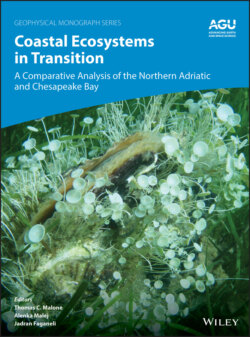Читать книгу Coastal Ecosystems in Transition - Группа авторов - Страница 37
2.5.3. Reservoir Filling
ОглавлениеA major challenge that is unique to CB is the filling of the Conowingo Reservoir of the Susquehanna River which has neared its sediment storage capacity after 90 years of operation. As sediment accumulates in this reservoir, the cross‐sectional area available for flow, and the vertical depth from water surface to sediment bed, decreases, thereby increasing the average horizontal flow velocity. Consequently, sediment trapping by the reservoir decreases and sediment load to CB increases. Numerous studies have demonstrated the declining trapping performance of this reservoir in recent decades (Hirsch, 2012; Langland, 2015; Zhang et al., 2013; Zhang, Hirsch, et al., 2016). Moreover, Zhang, Hirsch, et al. (2016) reported that such decline in reservoir trapping has occurred under a wide range of flow conditions. These changes, if not addressed, can hinder the attainment of the Chesapeake Bay Total Maximum Daily Load goals because the reservoir was expected to continue trapping sediments and nutrients at historical rates for another 20–30 years when those goals were established in 2010. Thus, the Chesapeake Bay Program partnership has worked to incorporate recent scientific understanding in upgrading its watershed model to better capture the temporal changes in reservoir function (Linker, Batuik, et al., 2013; Shenk & Linker, 2013), which will be used to adjust the goals of nutrient and sediment reductions by each jurisdiction.
